My favorite Agra Monuments
Agra
is home of World famous historical monument. Among these, no doubt,
Taj Mahal is most famous monument in Agra,
India. If i have to choose second best, it is hard as all of them are built finely
by different emperors and have different qualities and reasons to be built. Still let me give
you 3 of my best must see places Near Taj Mahal, Agra.....

Taj Mahal
An Elegy created in marble "or an" expression of
true love", the Taj Mahal was built by Emperor
Shah Jahan in the memory of his Begum Arjumand Bano better
known Mumtaj Mahal.
The Taj Mahal is a truly exquisite
piece of work.Recently Taj Mahal topped the list of
New 7 Wonders of the world.While the Taj Mahal is a great site
during the day, it is best viewed at night
during a full moon."The world is divided between those who
have seen the Taj and those who have not.
Very
soon, I hope to& be on the side that
has seen the Taj."Bill Clinton, President of The United States of
America.
(22 March,
2000)
More information on Taj Mahal Facts, you will
find it here.
 Red
Fort Red
Fort
I haven’t seen ever any fort so
beautiful as the Red Fort. Its situation, colour, building, water
fountains inside, all makes this place unique.It’s easy to spend at least a day
exploring the palaces, gardens and mosques of this 16th-century fort,
which offers perhaps the dreamiest view of the Taj Mahal .
This powerful fortress of
red sandstone encompasses, within its 2.5-km-long enclosure walls, the
imperial city of the Mughal rulers.
Emperor Shah Jahan was imprisoned in
the Agra Fort and was able to view the reflection of the Taj Mahal in a
precious diamond built strategically in one of the Fort walls.
Want more information on Agra Red Fort,
find it here.
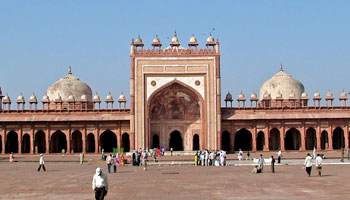 Fatehpur Sikri Fatehpur Sikri
Built during the second half of the 16th century by the Emperor Akbar,
Fatehpur Sikri (the City of Victory) was the capital of the Mughal
Empire for only some 10 years. The hill-top city lies 37 kms from Agra
in the state of Uttar Pradesh. It is simply mindblowing, made in pink
sandstone. The town is now deserted but the city is still an important historical site and worth seeing.The city itself did not last
long as a capital, but it has been preserved in all its Mughal glory and is still the object of architectural study and of the admiration
of millions.
More information on Fatehpur Sikri, you will find it here.
Sikandra
Sikandra is the mausoleum of Akbar. Akbar himself started construction of this beautiful monument. This structure has a perfect blending of Hindu, Christian, Islamic, Buddhist, Jain themes. Sikandra is named after Sikandar lodi, the Delhi ruler who was in power from 1488 to 1517.
Sikandra Fort is located in the western periphery of the city at a distance of about 10 kms from the city center. Sikandra the last resting place of the Mughal emperor Akbar. Akbar was the greatest of the Mughal emperors and one of the most secular minded royalties of his time.
Itmad ud Daula

Itmad-ud-daula has a special place in the chronicles of both history as well as architecture. This is precisely because Itmad ud Daula is the very first tomb in India that is entirely made out of Marble. This is actually a mausoleum that overlooks the River Yamuna and is a tomb of Mir Ghiyas Beg, a minister in the court of Shah Jahan.
The story of Itmad-ud-daula is an inspirational rag to riches saga. The tomb of Itimad-ud-Daulah is as interesting as the life of the person for whom it was built. Mirza Ghiyas-ud-din or Ghiyas Beg (later known as Itimad-ud-Daulah) was a poor merchant and lived in Persia (modern-day Iran).
Soor Sarovar 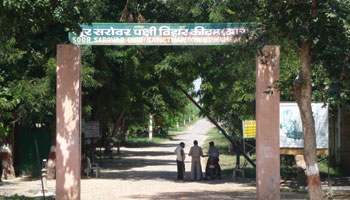
Soor Sarovar Wildlife Sanctuary lies in a sprawling 15-acre green expanse, 17 km from Agra, Uttar Pradesh. Established in 1991, the sanctuary has an area of 4 sq km. Local and migratory birds, jackal, mongoose and hares roam the sanctuary.The Soor Sarovar wetland at Keetham, Agra, is 175 km from Delhi. It is a place of natural beauty. The place inspired poet Soordas to compose the "Bhakti Kavya", one of the finest pieces of devotional poetry ever written.
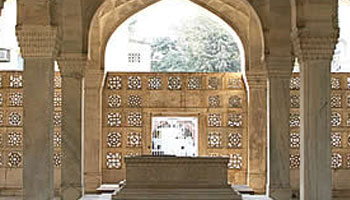 Chausat khambha Chausat khambha
Chausath Khamba monument was initially built as a hall in an innovative eclectic architectural style of the Mughal period. It was later converted into a tomb. It is a square structure constructed entirely of white marble. The structure (pictured with facades) has 64 columns that support twenty five bays. Each bay supports a dome. The domes are not visible externally since they are reverse domes (picture). The roof is flat. Each wall has five arches that are held by square pilasters. In each face, between each of five pilasters, marble trellised screens have been fixed.
Roman Catholic Cemetery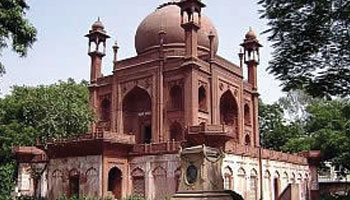
The Red Taj Mahal or John William Hessing’s Tomb was built by his wife in the memory of her husband. If Taj Mahal is known for the love of a husband for his wife, then on the other hand, the Red Taj Mahal is known for the love of a wife for her husband. It was built by Ann Hessing, wife the Dutch Soldier after his death in 1803 A.D. Who was Colonel John William Hessing? Colonel John William Hessing was in military services working with various rulers in India. He was hailed from Utrecht, Holland. He came to Ceylon for military services of Dutch E.I. Company in 1752 A.D. He was part of troops capturing Candia. He returned Holland after five years of war.
Chini ka Rauza
Maulana Shukrullah Shirazi was the Prime Minister of Mughal emperor Shah Jahah and also a famous poet. He composed poetry under the pseudonym of 'Allami'. He took fancy to building his own mausoleum in 1639 with elaborate ornamentation. He chose glazed tiles as his medium to create the masterpiece that would enshrine his tomb forever. Every portion of this unique monument is profusely adorned with bright color schemes, known as 'Chini ka Rauza'. Here, we discuss the general plan and layout of the building and the ornamentation techniques used in the monument in detail.
Mariam's Tomb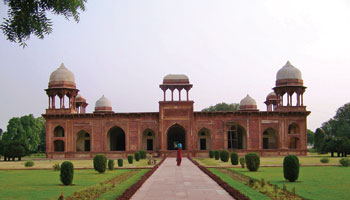
Mariam’s tomb is located on the left side of Agra-Mathura road, to the west of Akbar’s tomb, Sikandra. The tomb houses the mortal remains of Mariam Zamani, a Rajpt Princess of Amber (Jaipur) and the wife of Emperor Akbar and mother of Jahangir (Salim). The structure was originally a pleasure pavilion under Sikander Lodi who built it in AD 1495. Additions and renovations were made in 1623 AD when this baradari was converted into a tomb. The ground floor consists of some forty chambers built by Sikander Lodi, which bear faint traces of paintings on plastered walls. The centre of the ground floor houses the cenotaph of Mariam. The facades of the baradari had been veneered with red sandstone, which is cut into numerous panels and adorned with geometrical patterns carved in bas-relief. Each quoin of the structure is added with an ornamental octagonal tower. The tower is crowned by a pavilion supported by slender pillars. The upper storey contains the marble cenotaph, which is open to sky.
Chhatri of Raja Jaswant Singh
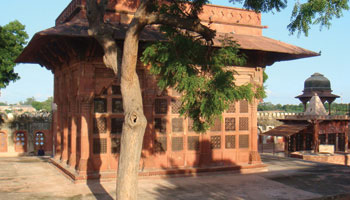
Chhatris are elevated, dome-shaped pavilions used as an element in Indian architecture, or funerary sites in India which have such structures built over them. Chhatris are basic element of Hindu as well as Mughal architecture. The term "chhatri" means umbrella or canopy. In the Shekhawati region of Rajasthan, chhatris are built on the cremation sites of wealthy or distinguished individuals. Chhatris in Shekhawati may consist of a simple structure of one dome raised by four pillars to a building containing many domes and a basement with several rooms. In some places, the interior of the chhatris is painted in the same manner as the Havelis.
Return from Agra Favorite Attractions to Taj Mahal India Travel Homepage.
|

